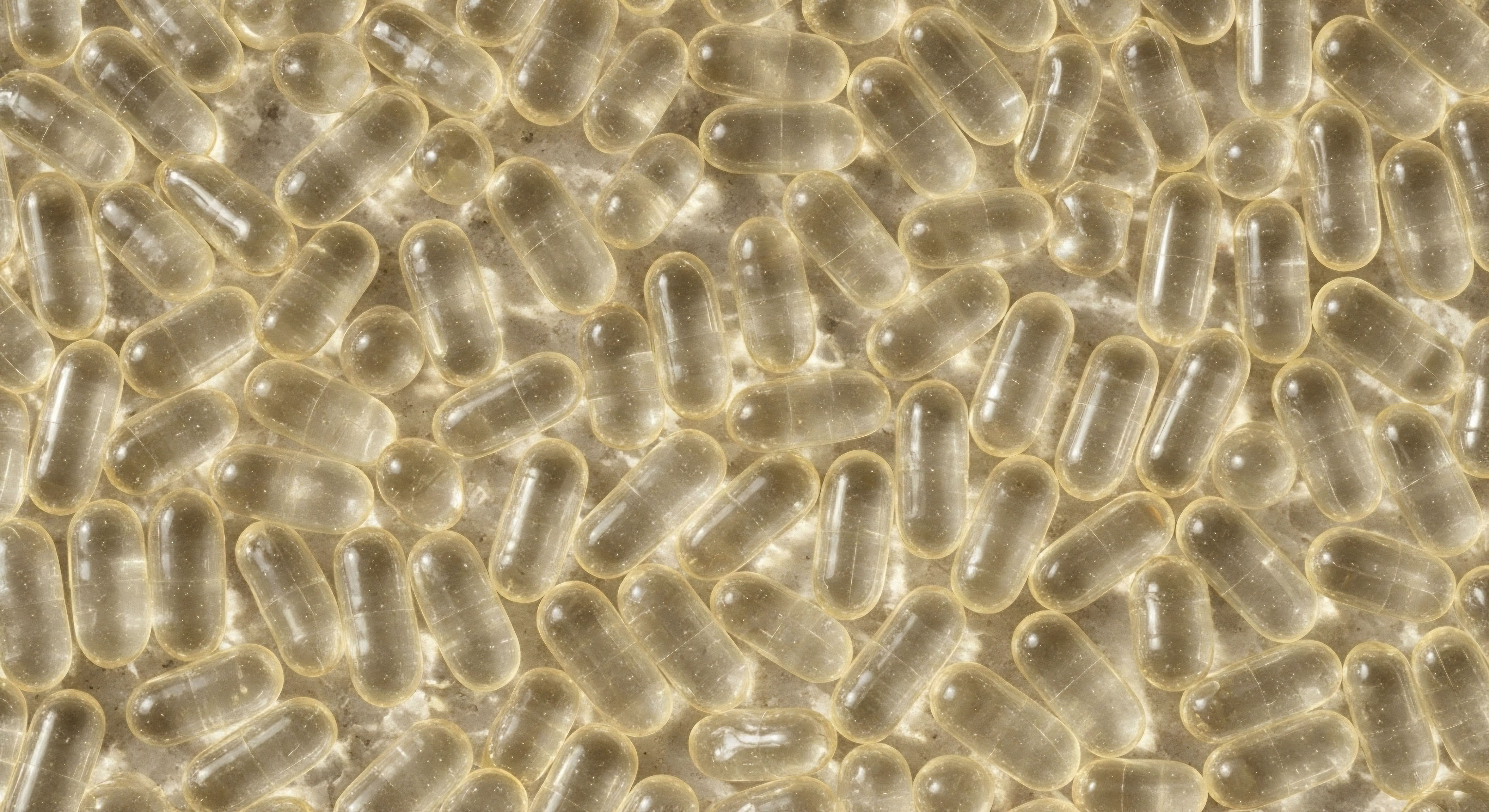

Fundamentals
You may be noticing changes in your body ∞ shifts in energy, mood, or physical well-being that feel difficult to pinpoint. Perhaps you’ve started a new medication and find its effects are not what you or your clinician expected. This experience of your own biology feeling unfamiliar can be unsettling.
It is a common starting point for a deeper investigation into personal health. Understanding how your internal systems work together is the first step toward recalibrating your body’s intricate processes. The conversation about health often involves hormones and medications, yet the relationship between them is a dynamic and deeply personal one.
Therapeutic peptides, which are small chains of amino acids, act as precise biological messengers. Their role extends into the very processes that determine how your body handles and utilizes pharmaceuticals.
Peptides influence pharmaceutical metabolism primarily by interacting with the body’s own enzymatic and disposal systems. Your body breaks down substances, from the food you eat to the medications you take, through a series of complex chemical reactions. A major system involved in this process is the cytochrome P450 (CYP) enzyme system, located predominantly in the liver.
These enzymes are the workhorses of drug metabolism, converting pharmaceuticals into forms that can be used by the body or excreted. Therapeutic peptides, which are themselves metabolized, can sometimes compete for the attention of these enzymes or influence their activity. This interaction is a critical aspect of personalized medicine, as it helps explain why different individuals may respond uniquely to the same medication. The process is not a simple one-way street; it is a complex biological dialogue.

The Body’s Metabolic Machinery
Think of your liver as a highly sophisticated processing center. When a pharmaceutical drug enters your system, it is tagged for processing by enzymes like those in the CYP family. These enzymes are designed to recognize and break down a vast array of chemical structures.
Peptides, being naturally derived or synthetically designed to mimic the body’s own signaling molecules, are also subject to breakdown. Their journey through the body involves degradation by enzymes called peptidases, which are found in the blood, kidneys, and liver. This process is distinct from, but can run parallel to, the metabolism of conventional drugs. The efficiency of these metabolic pathways directly impacts a drug’s efficacy and potential for side effects.

How Peptides Enter the Conversation
When you introduce a therapeutic peptide into your system ∞ for instance, a growth hormone-releasing peptide like Sermorelin or a healing peptide like PT-141 ∞ it begins its own journey of action and degradation. These peptides are designed to be highly specific, targeting certain cellular receptors to elicit a desired response, such as tissue repair or hormonal signaling.
Because they are active within the same biological environment as other medications, they can indirectly influence the metabolic landscape. For example, some peptides might modulate inflammatory responses. Inflammation itself has been shown to down-regulate the expression of certain CYP enzymes. This means that by addressing an underlying inflammatory condition, a peptide could potentially restore a more normal metabolic rate for other drugs.
Peptides primarily influence drug metabolism by interacting with the body’s enzymatic systems, particularly the cytochrome P450 enzymes responsible for breaking down pharmaceuticals.
The relationship is one of shared resources and systemic effects. While peptides are not typically direct inhibitors or inducers of CYP enzymes in the way many small-molecule drugs are, their broader physiological effects can alter the metabolic terrain.
This is a key reason why a holistic view of your health ∞ one that includes hormonal status, inflammation levels, and all therapeutic interventions ∞ is so important. Every substance introduced to the body contributes to the overall metabolic load and conversation. Understanding this allows for a more predictable and effective approach to personalized wellness protocols, ensuring that all components of your therapy work in concert to restore function and vitality.


Intermediate
For those already familiar with the basics of hormonal health and metabolic function, the next step is to understand the specific mechanisms through which peptides can modulate the metabolism of pharmaceutical agents. This knowledge is critical for anyone on a personalized wellness protocol, such as Testosterone Replacement Therapy (TRT) or Growth Hormone Peptide Therapy, who may also be taking other medications.
The interaction is not always a direct competition for a single enzyme but a more subtle, systemic influence that can alter a drug’s pharmacokinetics ∞ its absorption, distribution, metabolism, and excretion (ADME). Acknowledging these potential interactions allows for proactive management and optimization of therapeutic outcomes.
The primary pathway for the metabolism of a majority of pharmaceutical drugs is the hepatic cytochrome P450 (CYP) system. These enzymes are responsible for Phase I metabolism, where they modify the chemical structure of a drug, often preparing it for subsequent phases of detoxification and excretion.
Therapeutic peptides, on the other hand, are primarily broken down by peptidases throughout the body. While these are two distinct pathways, they are not entirely isolated. The potential for interaction arises from the broader physiological effects of peptides, such as their influence on inflammation, protein binding, and organ function, particularly in the liver and kidneys, which are central hubs for drug clearance.

Peptide Influence on Hepatic and Renal Function
The liver and kidneys are the primary organs responsible for metabolizing and clearing drugs from the body. Any substance that affects the health and function of these organs can, by extension, affect drug metabolism. Certain peptides are being investigated for their regenerative and protective effects on tissues.
For example, some peptides may support cellular health in the liver, which could theoretically enhance its metabolic capacity. Conversely, if a peptide or its metabolites were to place a significant load on the kidneys, it could compete with other drugs for renal clearance pathways. This is particularly relevant for medications that are primarily excreted unchanged by the kidneys.

Do Peptides Directly Inhibit or Induce CYP Enzymes?
The question of whether therapeutic peptides directly inhibit or induce CYP enzymes is a subject of ongoing research. Current understanding suggests that most therapeutic peptides, especially those larger than 2 kDa, have a low likelihood of causing clinically significant drug-drug interactions (DDIs) via direct CYP modulation.
Unlike many small-molecule drugs that can directly bind to and either block (inhibit) or ramp up (induce) the activity of CYP enzymes, peptides generally do not fit into the active sites of these enzymes. However, smaller peptides or those with unusual chemical modifications might present a higher risk. Regulatory bodies and pharmaceutical companies are actively working to establish clear guidelines for assessing the DDI potential of new peptide therapeutics.
The influence of peptides on drug metabolism is often indirect, stemming from their systemic effects on inflammation, organ function, and protein binding rather than direct competition for metabolic enzymes.
The following table outlines the primary metabolic pathways for peptides and conventional small-molecule drugs, highlighting the key differences and potential areas of indirect interaction.
| Characteristic | Therapeutic Peptides | Small-Molecule Drugs |
|---|---|---|
| Primary Metabolic Pathway | Proteolytic degradation by peptidases in blood, liver, and kidneys. | Oxidative metabolism by Cytochrome P450 (CYP) enzymes in the liver. |
| Primary Site of Metabolism | Ubiquitous; occurs in various tissues and the bloodstream. | Primarily the liver, but also the gut and other organs. |
| Direct CYP Interaction | Generally low, especially for larger peptides. | Common; many drugs are inhibitors, inducers, or substrates of CYP enzymes. |
| Indirect Influence | Can occur via modulation of inflammation, organ function, or protein binding. | Can also occur, but direct interactions are more frequently the primary concern. |

Systemic Inflammation and Its Metabolic Consequences
A significant and often overlooked mechanism by which peptides can influence drug metabolism is through the modulation of systemic inflammation. Chronic inflammation is known to suppress the expression and activity of several key CYP enzymes, including CYP3A4, which is responsible for metabolizing an estimated 50% of all clinical drugs.
Certain therapeutic peptides, such as those used for tissue repair and immune modulation, can help to reduce systemic inflammation. By lowering inflammatory cytokines, these peptides can potentially restore normal CYP enzyme function. This could have the effect of increasing the metabolism of a co-administered drug, potentially lowering its concentration in the blood and altering its efficacy. This highlights the importance of considering a patient’s inflammatory status when managing their medication regimen.
For individuals on complex wellness protocols, understanding these interactions is key. For example, a man on TRT with Anastrozole to manage estrogen levels should be aware that other therapies, including peptides, could influence how his body processes these medications.
Similarly, a woman using low-dose testosterone and progesterone for hormonal balance might find that adding a peptide for metabolic health could shift how she responds to her primary hormone therapy. The goal is to create a synergistic effect, where all components of a protocol work together to achieve optimal health. This requires a sophisticated understanding of the body’s interconnected systems and a partnership with a clinician who can navigate these complexities.


Academic
A sophisticated analysis of how peptides influence pharmaceutical metabolism requires moving beyond general principles to examine the specific molecular and systemic interactions at play. From an academic standpoint, the issue is not a simple binary of interaction versus no interaction.
It involves a nuanced appreciation of pharmacokinetics (PK) and pharmacodynamics (PD), the role of protein binding, and the subtle, yet potentially significant, impact of peptides on the expression of metabolic enzymes and drug transporters. For the clinician-scientist and the informed patient, this level of detail is essential for designing truly personalized and optimized therapeutic protocols, particularly when combining peptide therapies with conventional pharmaceuticals.
The metabolic fate of most therapeutic peptides is catabolism by proteases and peptidases into smaller peptides and constituent amino acids, which then enter the body’s general amino acid pool. This process is fundamentally different from the primary metabolic route for the majority of xenobiotic small-molecule drugs, which involves Phase I functionalization (e.g.
oxidation, reduction, hydrolysis) by cytochrome P450 (CYP) enzymes and Phase II conjugation reactions. While this distinction suggests a low probability of direct competitive inhibition at the active site of CYP enzymes, it does not preclude other forms of interaction. The focus of advanced inquiry, therefore, shifts to indirect mechanisms and the potential for interactions with less common metabolic pathways.

Impact on Cytochrome P450 Enzyme Expression
While direct inhibition of CYP enzymes by peptides is rare, the potential for peptides to modulate the expression of these enzymes is an area of active investigation. The expression of CYP genes is regulated by a complex network of nuclear receptors, such as the Pregnane X Receptor (PXR) and the Aryl Hydrocarbon Receptor (AHR).
Many drugs induce CYP enzymes by activating these receptors. The question is whether peptides, or the downstream signaling pathways they activate, can influence this regulatory network. For instance, many peptides exert their effects by binding to G-protein coupled receptors (GPCRs), initiating intracellular signaling cascades that can, in turn, affect gene transcription.
A peptide that modulates pathways involved in cellular stress or inflammation could theoretically lead to the downregulation of CYP enzyme expression. This is a known phenomenon with inflammatory cytokines, which are potent suppressors of major CYPs like CYP3A4 and CYP2C9. Therefore, a peptide with anti-inflammatory properties could, conversely, lead to an upregulation of these enzymes back to their normal baseline, thereby altering the metabolism of a co-administered drug.

What Is the Role of Drug Transporters?
Beyond enzymatic metabolism, the disposition of many drugs is critically dependent on transporter proteins, such as P-glycoprotein (P-gp) and Organic Anion-Transporting Polypeptides (OATPs). These transporters are located in key tissues like the intestines, liver, kidneys, and the blood-brain barrier, and they control the entry and exit of drugs from cells.
An emerging area of research is whether peptides can act as substrates, inhibitors, or inducers of these transporters. A recent industry survey indicated that while in vitro testing for transporter interactions is becoming more common for peptide drugs, the clinical significance of these findings is still being established.
A peptide that inhibits a key efflux transporter like P-gp in the gut wall could potentially increase the oral bioavailability of a co-administered drug, leading to unexpectedly high plasma concentrations and an increased risk of toxicity.
Advanced assessment of peptide-drug interactions focuses on indirect mechanisms, including the modulation of CYP enzyme expression via inflammatory pathways and interactions with critical drug transporter proteins.
The following table provides a detailed comparison of the interaction potential for different classes of therapeutic agents, offering a more granular view for academic consideration.
| Interaction Mechanism | Small-Molecule Drugs | Therapeutic Peptides (>2 kDa) | Therapeutic Peptides (<2 kDa) |
|---|---|---|---|
| Direct CYP Inhibition/Induction | Common and clinically significant. | Low likelihood; generally considered a low risk. | Higher potential risk, requires case-by-case evaluation. |
| Modulation of CYP Expression | Can occur, often via nuclear receptor activation. | Possible via indirect mechanisms (e.g. anti-inflammatory effects). | Possible, with a slightly higher theoretical risk than larger peptides. |
| Interaction with Drug Transporters | Well-documented for many drugs (e.g. P-gp, OATPs). | Under investigation; considered a lower but possible risk. | Higher potential for interaction, particularly with modified structures. |
| Competition for Plasma Protein Binding | Can occur, displacing other drugs and increasing their free fraction. | Possible, especially for peptides designed to bind to albumin. | Possible, though less common than for highly protein-bound small molecules. |

Case Study Considerations in Personalized Medicine
Let’s consider a practical application within a personalized medicine context. A patient is on a stable regimen of TRT, which includes weekly injections of Testosterone Cypionate and a low dose of Anastrozole, an aromatase inhibitor. Anastrozole is metabolized primarily by CYP3A4.
The patient then begins a protocol with a growth hormone secretagogue peptide, such as Ipamorelin/CJC-1295, to improve body composition and recovery. These peptides have been shown to have systemic effects, including potential modulation of inflammatory markers. If the peptide therapy successfully reduces subclinical inflammation, it could lead to an increase in the expression and activity of CYP3A4.
This, in turn, would accelerate the metabolism of Anastrozole, potentially reducing its plasma concentration and its effectiveness at controlling estrogen levels. The clinical manifestation might be a subtle return of symptoms related to high estrogen. This scenario illustrates that the interaction is not a direct chemical interference but a systemic, physiological modulation. It underscores the necessity for vigilant monitoring of both symptoms and lab markers when adjusting complex therapeutic regimens.
- Testosterone Replacement Therapy (TRT) ∞ The base protocol, often involving testosterone and an aromatase inhibitor like Anastrozole.
- Growth Hormone Peptide Therapy ∞ The addition of peptides like Sermorelin or Ipamorelin, which can have systemic anti-inflammatory effects.
- Metabolic Intersection ∞ The peptide’s anti-inflammatory action may restore normal CYP3A4 activity, potentially increasing the metabolism of Anastrozole and altering the testosterone-to-estrogen ratio.
This level of analysis reveals that ensuring therapeutic success in modern wellness protocols requires a systems-biology approach. It is about understanding the interconnectedness of the endocrine, immune, and metabolic systems. The influence of a peptide on pharmaceutical metabolism is a function of this complex biological network. As our understanding of these interactions deepens, so too will our ability to fine-tune therapies for maximum safety and efficacy.

References
- Chia, C. S. “A Review on the Metabolism of 25 Peptide Drugs.” Applied Sciences, vol. 11, no. 5, 2021, p. 2173.
- Grimm, H. P. et al. “Pharmacokinetics and Pharmacokinetic-Pharmacodynamic Correlations of Therapeutic Peptides.” Clinical Pharmacokinetics, vol. 52, no. 8, 2013, pp. 631-44.
- Muttenthaler, M. et al. “Therapeutic Peptides ∞ Recent Advances in Discovery, Synthesis, and Clinical Translation.” Chemical Reviews, vol. 121, no. 15, 2021, pp. 8933-9042.
- Nørgaard, R. A. et al. “Industry Perspective on Therapeutic Peptide Drug-Drug Interaction Assessments During Drug Development ∞ A European Federation of Pharmaceutical Industries and Associations White Paper.” Clinical Pharmacology & Therapeutics, vol. 113, no. 4, 2023, pp. 749-61.
- Zier, M. et al. “Role of Protein-Protein Interactions in Cytochrome P450-Mediated Drug Metabolism and Toxicity.” Chemical Research in Toxicology, vol. 27, no. 9, 2014, pp. 1449-62.
- Fahmi, O. A. et al. “Evaluation of Peptides as Cytochrome P450 Inhibitors ∞ A Study of the Structure-Inhibition Relationship.” Drug Metabolism and Disposition, vol. 36, no. 9, 2008, pp. 1897-904.
- Lin, J. H. and Lu, A. Y. “Role of Pharmacokinetics and Metabolism in Drug Discovery and Development.” Pharmacological Reviews, vol. 49, no. 4, 1997, pp. 403-49.
- Guengerich, F. P. “Cytochrome P450 and Chemical Toxicology.” Chemical Research in Toxicology, vol. 21, no. 1, 2008, pp. 70-83.
- Grant, D. M. “Detoxification Pathways in the Liver.” Journal of Inherited Metabolic Disease, vol. 14, no. 4, 1991, pp. 421-30.
- Evans, D. C. “Drug-Drug Interactions with HMG-CoA Reductase Inhibitors (Statins).” Annals of Pharmacotherapy, vol. 33, no. 7-8, 1999, pp. 839-46.

Reflection
You have now explored the intricate biological dialogue between peptides and pharmaceutical metabolism, from foundational concepts to the complexities of systemic interactions. This knowledge serves as a powerful tool, shifting the perspective from being a passive recipient of care to an active participant in your own health narrative.
The journey to reclaiming vitality is a personal one, built upon understanding the unique language of your own body. The information presented here is a starting point, a map to help you ask more informed questions and to see your health not as a series of isolated symptoms, but as an interconnected system.

Charting Your Own Path
Consider the therapies and supplements you currently use. How might they be interacting within your body’s metabolic ecosystem? Reflect on your own experiences with medications ∞ have you ever felt that your response was different from the expected norm? This is the beginning of personalized health intelligence.
The ultimate goal is to work in concert with your biology, using these advanced tools to restore balance and function. This path requires curiosity, diligence, and a collaborative relationship with a clinical guide who understands this complex terrain. Your body is constantly communicating; learning to interpret its signals is the most empowering step you can take.



